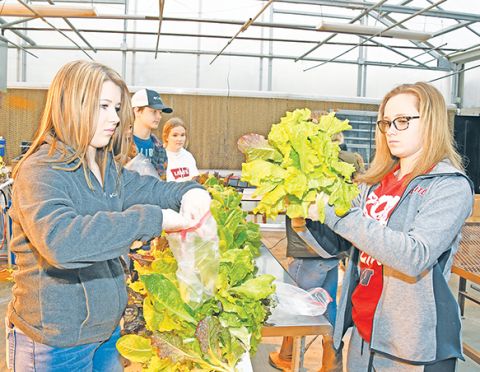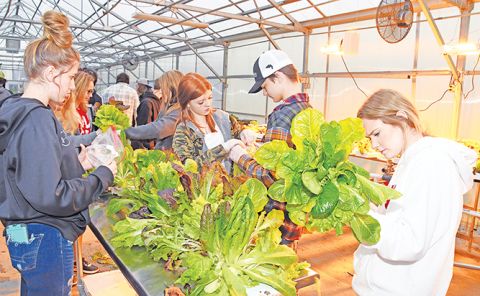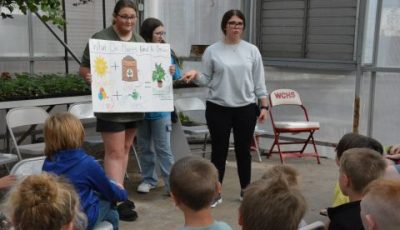WCHS agriculture students use hydroponic system to grow first of many new crops of lettuce

If you grew up in southeastern Kentucky, then there is a pretty good chance that at some point in your life you have worked in a garden.
Come spring the ground was tilled. You dug a hole, put down some fertilizer and planted a seed. Then a few weeks later, depending on what you planted and the growing conditions, you picked your produce.
It was productive. You got a good number of vegetables and probably canned or froze some of it for later. Problem was you could only grow your food outside in the ground for a few months of the year.
But what if you could have grown your plants year round and instead of using dirt to grow your plants, you instead grew them in water?
 Some Whitley County High School agriculture students don’t have to imagine such a system. They are already using a hydroponic system in the school greenhouse, and reaped the benefits of their first crop Friday morning harvesting their first heads of lettuce.
Some Whitley County High School agriculture students don’t have to imagine such a system. They are already using a hydroponic system in the school greenhouse, and reaped the benefits of their first crop Friday morning harvesting their first heads of lettuce.
“Our population is growing. Each time we add people we are losing farm land due to houses and urbanization and those kind of things. We have to learn to be more efficient on the ground that we have. Hydroponics is one way we can do that,” said Brian Prewitt, who teaches the agriculture, horticulture and greenhouse classes at WCHS.
“With a hydroponics system, you can grow 30 times more produce than you can on that same plot of land outside. We can grow year round, and it is faster and more efficient.”
The school started putting the hydroponic system together in the fall, and planted the first crop of lettuce around Thanksgiving.
The lettuce plants start as seeds in the nursery for four weeks before being put in the hydroponics rows to grow for another four weeks.
It takes the lettuce plants a total of eight weeks to grow using the hydroponic system compared to about 12 weeks growing outside in the dirt.
“Right now, you can’t even grow it in the ground. It would be too cold outside,” Prewitt noted. “Every week we have 72 plants of lettuce that we are going to harvest.”
 Prewitt said the school’s home economics teacher noted that there is about 19 percent waste growing the lettuce in the ground from the time you harvest it until the time you get it on the plate compared to about 2 percent loss via hydroponics.
Prewitt said the school’s home economics teacher noted that there is about 19 percent waste growing the lettuce in the ground from the time you harvest it until the time you get it on the plate compared to about 2 percent loss via hydroponics.
“Through hydroponics you don’t have any ground contamination and those kind of things,” he added.
The lettuce that the students are growing is referred to as a summer salad mix. It contains four different types of lettuce, including the purple romaine and the green romaine to give it a little pop of color.
The students are also experimenting with a couple of other varieties of lettuce too, and some spices, such as basil.
While Friday’s crop was grown in horizontal rows, the students are also experiments with growing crops in vertical rows.
“If you think about it, if I can grow vertical then I can grow more plants than I can horizontally. It’s about efficient use of space,” Prewitt said. “That is what agriculture is going to do is we have to be more efficient on the land we have whether that is growing vertical, growing in the greenhouse, or whatever.”
The students will soon be adding tomatoes to their hydroponic efforts once the fertilizer for it arrives.
Tomatoes require a slightly different type of growing system, and take about four months to grow from seed to harvest through the hydroponic system.
“The thing about tomatoes grown hydroponically is that you can pick and harvest continuously year round. Whereas tomatoes in a garden, you might harvest in four to six weeks and be done with them. I have heard of people harvesting them up to two years on the same plants with a hydroponics system,” Prewitt noted.

This equipment is used to regulate the amount of fertilizer and other nutrients used in the growing process.
Prewitt concedes there was a learning curve in regards to figuring out how to use the hydroponic system.
“I commend our students. They have had some great ideas on how to fix things. To test water, we would send it to the University of Kentucky and wait three weeks to get our results back. That is pretty slow. One of the kids said why don’t we take it to Leisure Time Pools and have them check it. We got results back that day,” Prewitt said.
“The kids are smart. They think of things differently than we do. These kids are learning. They are troubleshooting things and figuring things out.”
Prewitt said that he thinks hydroponics is the future of farming.
“Here at the ag department we are always looking at how can we be innovative showing these kids new technology,” Prewitt said. “This is just a way we can show kids this is what is going to happen in the future. This is where we think the jobs are going to be.”
Prewitt noted that the future of the horticulture industry is probably going to be companies like AppHarvest, which are building these 50-60 acre greenhouses in Kentucky and employing 300 – 400 people at each site.
“Like I tell the students all the time, it is not the way your grandpa

Students are also experimenting with growing lettuce in vertical rows using a hydroponics system.
gardened at all. They are excited about it. Everything from the grow lights to the electronics,” Prewitt said. “These kids are interested in the electronics. I have an ap on our phones that will tell us what is going on with this system, what nutrients are there and all those things.”
The students took home their first harvest Friday to enjoy the fruits of their labor.
Prewitt said that the eventual plan for future harvests is to sell it to the school.
“The lettuce basically would leave here and go to the cafeteria that is fresh,” he added.
Mercedes Wells, a senior, who has been taking vo-ag classes since she was a freshman in the high school, said she was really excited when the school added the hydroponics late last year.
“I love it. It is a lot more efficient than growing in just dirt and stuff like that. In dirt you can encounter problems and stuff like that. With this, you can control what goes in the plants and you know how they are grown. I would say you are more likely to eat it like that,” said Wells, who plans to attend college and become a veterinarian.
Donna Anderson, a freshman, agreed that the hydroponic system is cool.
“It is a neat way to do it. It is cleaner. I like it better,” said Anderson, who had never worked in a garden before.
She noted that the thing that really surprised her was how quickly the plants grew with the hydroponic system.










